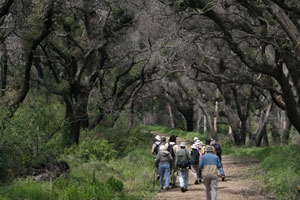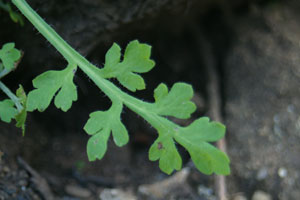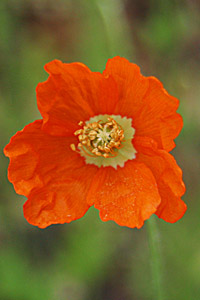April Field Notes
by Gabi McLean
(reprinted from The Paintbrush, May-August 2006, California Native Plant Society, San Gabriel Mountains Chapter)
|
It was only in mid-February that we treasured the winter storms after weeks without precipitation. Since then though, we have had plenty of water falling from the sky. It seemed to rain mostly on weekends and so we ended up hiking during showers quite a bit in the last eight weeks. I enjoyed being in the wilderness, the cool air blowing hard at times, driving rain one moment, hail another—and then sunshine, dramatic clouds casting shadows over the hills and snow-capped mountains, and the mood shifting by the second. We were looking for signs of the changing season. Flowering annuals were sparse when compared with their abundance in the previous year, what we attributed to a combination of reasons. Last year’s exceptional wildflower season was partly due to the fires. They had cleared the brush and exposed the soil, providing space and light to seeds that need those conditions, and provided the smoke and ashes that some seeds need to germinate, the seeds of the “fire followers”. After just one season, the earth was no longer bare and so we missed most of the fire followers. In addition, the uncharacteristic weather pattern—early rain in October, then a dry spell until February, and unseasonably hot in January—could well have aborted a first crop of wildflowers. But we found other signs of spring, recovery, and renewal. There were buds and flowers on shrubs and trees, fragrances of new growth and fresh foliage, insect sounds and other signs of wildlife, moisture in the air, and now and then even sunshine. 
Evey Canyon
Photo by Gabi McLean
We explored the areas that we had visited last year in April, just six months after the fires. In Placerita Canyon at the northwestern edge of the San Gabriel Mountains, I remembered the Whispering Bells, Yellow-throated Phacelia, Popcorn Flowers, White Pincushion, Bluedicks, many mounds of Miner’s Lettuce and Wild Cucumber covering the scorched hillsides. We had enjoyed seeing Shiny Lomatium, White Snapdragon, and Yellow Monkeyflower. This year, Deerweed and Yerba Santa, along with the resprouting shrubs of Chamise, Scrub Oak, Redberry and Toyon, were dominating the hills. None of these shrubs were in bloom yet, except for one Holly-leaf Redberry whose yellow-green flowers covered the stems in such profusion that we first did not recognize the species. We found quite a few very young White Pincushion plants, and just a few Whispering Bells that were in bud but not in flower, along with one or two Little Blazing Stars. On the firebreak at Manzanita Mountain, I discovered several thick bundles of sulfur-yellow flowers, just four inches tall and easily crushed by bike riders scurrying up the ridge, was the root-parasite Clustered Broomrape, Orobanche fasciculata. |

Fire Poppy leaf
Papaver californicum Photos by Gabi McLean In Evey Canyon, I remembered the field of fire poppies exactly one year ago. The leaves reminded me of Baby Blue Eyes or Fiesta Flower leaves. It was just such an impression to find the deep-orange flowers seemingly floating in mid-air. The drooping buds belied the open flower reaching proudly up in the sky. This year, we were looking for those rare beauties again but we didn’t find a single one. 
Fire Poppy flower
I enjoy watching the wild lands recover and renew after fire, and observing birds, lizards, deer and tell-tale signs of other wildlife returning. And I wonder if these wondrous places will still be here for our children and grandchildren to explore and experience the many lessons of nature. |
Keywords: Gabi McLean, Cliff McLean, Gabriele McLean, Clifford McLean, Nature at Hand, Gabi Horn, Gabriele Horn, Plants of the San Gabriel Mountains: Foothills and Canyon, Interpretive Guide on CD, Plants of the San Gabriel Foothills and Canyons, California native plants, Pasadena, Los Angeles, Los Angeles County, San Gabriel Valley, Southern California, Covina, natural, nature photography, photograph, environmental education, naturalist, docent, hike, hiking, CD-ROM, California native garden, gardening, flowers, wildflowers, San Gabriel Mountains, Angeles National Forest, California Native Plant Society, CNPS, Eaton Canyon Nature Center Associates, ECNCA, Mt. Baldy, Mount Baldy, Mt. San Antonio, Mount San Antonio